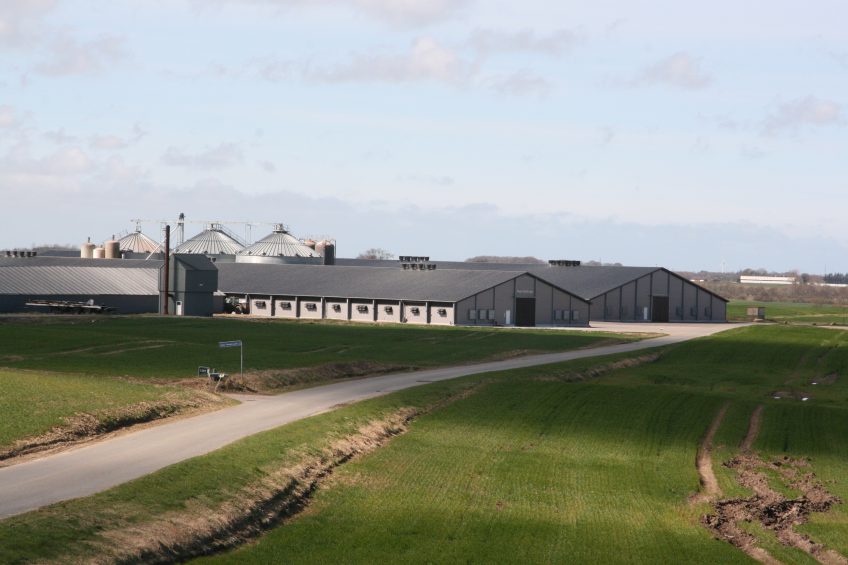Focus on cost price and quality

With only 110 million broilers produced per year, of which just 10 million make it into the export market, Denmark is just a small player in broiler meat production. That said, the high consumer demands, welfare and health legislation plus the constant pressure on retail prices make it essential that Danish producers are on top of their game. Poultry World visited Niels Erik Thomsen’s farm, where optimising live bird performance is the main focus.
When one takes a closer look at the 400 hectare arable farm of Niels Erik Thomsen (56), one can guess what his background is. For producing wheat, barley and rapeseed on such a relatively small patch of land, the number of heavy machinery is pretty outstanding. Hence, Thomsens background as a tractor mechanic.
Until 2012 produce from the 400 hectares was mainly used for fattening pigs, still 6,000 are on the current farm, resulting in 24,000 pigs going to slaughter every year. “It was my neighbour who convinced me, back in 2011, not to invest anymore in extra pig houses, but to start a new branch with broiler production.” The economics presented by the parent stock farmer next door, looked convincing. When it comes to efficiency and economics, the machinery department is the only part of the farm that has room for improvement. If deemed necessary of course.

In 2012 Thomsen built his first poultry house, followed by one of the same design in 2015. In doing so, he broke with tradition. Standard poultry houses in Denmark usually measure 100 meters long and 20 meters wide. Thomsen decided to go for a staggering 40 meters wide. Each of the houses are divided in to 2 compartments, the total farm holds 230,000 birds, or 250,000 when thinning is applied. Per year, in 8 rotations the farm delivers 1.9 million broilers to market. This resulted in a margin before tax of € 800,000 in 2016. “The extra wide houses made it possible to save a lot of money in construction per square meter. The state of the art houses, with floor heating, heat exchangers and Skov ventilation equipment and computers cost about € 200 per square meter, instead of € 300. However, designing proper ventilation and airflow in the 17 meter high houses, caused some headaches.” Incoming air via the side air inlets is ‘lifted’ by warming it up via extra heating fixtures mounted on the sidewalls. Spent air is discarded via roof mounted exhaust fans, creating 30-40 Pascal under pressure. The houses are a treat to work with as a farmer. Thomsen employs one man to look after both houses. “For him it is only a part-time job, the rest of the time he helps out in the arable department.”

Heat is cheap
From a design perspective, the houses are well insulated. The steel structured building has a double roof structure, with insulated inner ceilings and a meter high space between this and the actual outside roof. Thomsen: ‘’This helps me to keep the houses cool in hot weather. But the rest of the year we like it hot inside. When we see some of our birds panting, then we know we are in ‘the zone’.” Heat is cheap in Denmark, most of the farms burn big bales (straw) in a separate burner, from which the heat is fed into a central heating system. The straw is nearly free, coming from their own grain field. “We have the tendency to keep it a little warmer than recommended. That helps us keep the litter bone dry and the quality of the birds’ feet good. It also encourages growth and helps us to get to a target live weight of 2.2 kilo’s in 32 days, with a calculated feed conversion of a mere 1.46.”

A good house climate is ensured by a heat exchanger per compartment (4 in total on farm). Thomsen: “The first 14 days we run entirely on the heat exchanger. Only when the birds are older, do we ventilate via the wall inlets. That is part of our success in keeping the birds healthy. That is not only important for our technical results, but also to comply with rules and regulations concerning animal welfare and (no) antibiotic use.” The farmer knows that the day old chicks are still really fragile. He learned this the hard way, as Denmark had some issues when Thomsen started in 2012. E-coli and staph infections were up at the time, with 25% of flocks infected. This led to exceptionally high antibiotic usage in Denmark of 5% and farmers had to accept 30% rejects at the processing plant. According to the farmer, the problem carried on for quite some time, before it was addressed in a proper way. “In Denmark there is only one hatchery. The lack of competition does not make them do a bad job, but sometimes they have too easy a job. Since the E-coli problems, the DOC quality has improved. The source of the problem was identified in only 5 parent stock flocks, which were subsequently culled. Now we see E-coli only in about 6% of the broiler flocks.”

One of the learnings to prevent skin damage due to scratching and subsequent inflammation in diseased birds, resulting in rejects, is still in place. Reducing light intensity to 20 lux or even lower kept the birds calm and prevented stress. Thomsen: “They also waste no energy with moving around that much. They still find their way to the feeder pans, eat the same, but have better feed conversion. That is where there is money to gain in many farms around the world.” He concludes: ‘’With proper attention on cost price and quality, its good business making chicken in this country. If the opportunity arises I will certainly look for the possibility to build another 1 or 2 houses of the same design.”
Also read: Added value in niche markets













